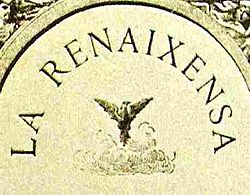Renaixença
| Catalan / Valencian cultural domain |
|---|
 |
The Renaixença (Catalan pronunciation: [rənəˈʃɛnsə], Catalan pronunciation: [renajˈʃɛnsa] (also written Renaixensa before spelling standardisation) was an early 19th-century romantic revivalist movement in Catalan language and culture, akin to the Galician Rexurdimento or the Occitan Félibrige movements. The movement dates to the 1830s and 1840s, but lasted into the 1880s, when it branched out into other cultural movements. Even though it primarily followed a romantic impulse, it incorporated stylistic and philosophical elements of other 19th century movements such as Naturalism or Symbolism. The name does not indicate a particular style, but rather the cultural circumstances in which it bloomed.
Overview
Along with the later modernisme, this movement ended a period of Catalan cultural decline commonly known as Decadència, that dated back at least to defeat in the War of the Spanish Succession (1701–1714)[2] and the subsequent Nueva Planta decrees, which suppressed Catalonia's traditional institutions, privileges, and fueros beginning January 16, 1716. Thus, the aim of this movement was the full restoration of Catalan as a language of culture, not only through the promotion of various forms of art, theatre and literature in this language, but also attempting to establish a normative standard for the language, something however not fully accomplished until the first quarter of the 20th century.
As with most of the other Romantic movements, it was noted for its admiration of the Middle Ages, which was often reflected in art, and in Barcelona, the literary contest known as Jocs Florals or Jocs de la Gaia Ciència was revived.
The Renaixença occurred not only in Catalonia proper, but also in other Catalan-speaking regions such as the Balearic Islands.[3]
A journal particularly associated with the movement was the magazine La Reinaxença, from which the name was actually taken - originally spelt Renaixensa before the Fabrian spelling reform.
Notable individuals related to Renaixença
- Bonaventura Carles Aribau, writer. - His poem Oda a la pàtria is usually acknowledged to have kick-started the movement.
- Manuel Milà i Fontanals, linguist, philologist and troubadour literature scholar, of great influence and one of the main initiators of the Renaixença.
- Joan Maragall, poet, translator from Greek and German, journalist and essayist.
- Jacint Verdarguer, poet, penned L'Atlàntida and the Catalan national epic, Canigó.
- Àngel Guimerà, playwright.
- Narcís Oller, novelist heavily influenced by Émile Zola's naturalism, chronicled the Industrial Revolution, society and changing mindsets in his novels.
- Frederic Soler, known as Pitarra, playwright who favoured colloquial Catalan of his time over more classical conventions.
- Joaquim Rubió i Ors, poet, his moniker to be variously written as Lo Gayté del Llobregat, El Gaiter del Llobregat, among others (depending on the spelling used)
- Víctor Català (real name Caterina Albert i Paradís), symbolist writer.
- Martí Genís i Aguilar, writer.
- Antoni Puig i Blanch, poet.
- Francesc Camprodon, poet.
- Víctor Balaguer, writer. Used the pseudonym Lo trovador de Montserrat.
Notes
- ^ Jordi Falgàs i d'altres, Barcelona and Modernity, Picasso Gaudí Miró Dalí, ISBN 0-300-12106-7, 2006.
- ^ Art Nouveau in Catalonia, on GaudiAllGaudi.com. Accessed 26 March 2006.
- ^ The Renaixença, part of Els Moviments Literaris Contemporanis a les Balears, on mnm.uib.es. Accessed 26 March 2006.
External links
- Renaixença, from the Nou diccionari 62 de la literatura catalana (2000). Page also contains extensive links to other reference-quality material. In Catalan.
- Renaixença, civisme i nacionalisme on the site of the Museu d'Història de Catalunya. In Catalan.
- La Renaixença Template:Ca icon
